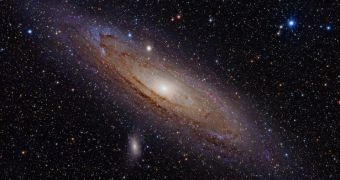Astronomers are currently in the process of refining their original predictions about the fate of the Andromeda-Milky Way galactic system. They say that it could be possible the two objects will not hit each other after all.
The earliest predictions about a potential collision were based on the fact that our neighboring galaxy was found to be moving towards us fast. This implied that, a few billion years from now, the two would collide, giving birth to a massive cosmic object.
The resulting spiral galaxy would have been incredibly large, given that the Milky Way is already 100,000 light-years in diameter. The collision would have also triggered intense stellar formation.
This process takes place as masses of hydrogen gas in both galaxies would have been stirred by the massive gravitational and tidal interactions caused by the two galaxies' large masses.
But the latest data on the nearby galaxy indicate that there is a possibility that the two will not collide. This has yet to be established for sure, but investigators in the United States are currently in the process of confirming the potential finding, Daily Galaxy reports.
The research is conducted by scientists at the Socorro, New Mexico-based National Radio Astronomy Observatory (NRAO), who are led by expert Loránt Sjouwerman. The group managed to discover a laser-like spot of light called a maser, which it plans to use for analyzing Andromeda.
The maser (Microwave Amplification by Stimulated Emission of Radiation) source is being used in ongoing studies to determine the amount of sideways motion that Andromeda is displaying.
If that amount is significant, then our neighbor may be moving fast enough to avoid a full-blown collision with the Milky Way billions of years from now.
Discovering this maser was a very important step forward. Generally, the motion of galaxies can be determined by analyzing the Doppler shift of the light they emit, but Andromeda is simply too close to allow for the use of this technique.
The radiation-emitting structure was produced by stars heating up surrounding interstellar methanol molecules, and exciting them to produce light in the microwave region of the electromagnetic spectrum.
“Measuring the proper motion of Andromeda is key to determining the fate of the Milky Way,” explains astrophysicist Mark Reid, who is based at the Harvard-Smithsonian Center for Astrophysics (CfA), in Cambridge.
“Such a measurement is best done with a compact, bright source such as a maser, but until now no maser strong enough for current telescopes to measure has been detected,” he concludes.

 14 DAY TRIAL //
14 DAY TRIAL //